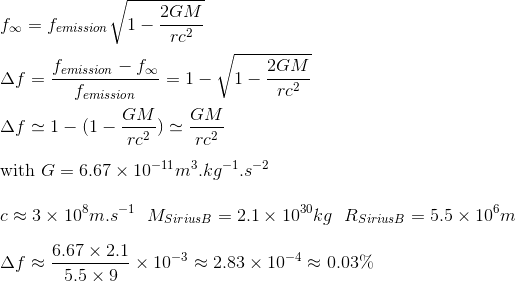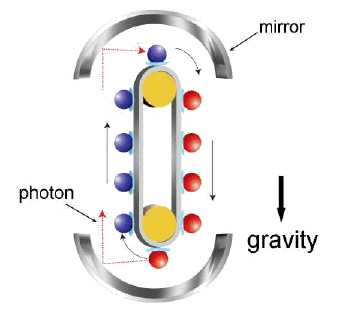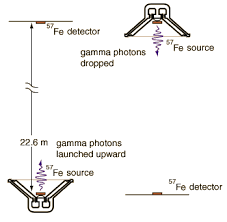So how can we measure the gravitational redshift?
As we recall from our previous article Gravitational redshift or Einstein effect - Part I, the expected amount of redshift for light from the surface of a massive object reaching a distant observer is proportional to the object's mass M divided by its radius r

One can first think that the gravitational redshift of light coming to us from the Sun could be a good candidate, but the accuracy is not very good because of gas motions on the solar surface: in this case, the Doppler shifts due to the moving gas are somewhat larger than the gravitational redshift due to the light having to climb out of the field of the sun.
So we have to think to another candidate with a potentially stronger redshift effect, meaning a bigger ratio mass/radius.
Actually, the stars that astronomers call White Dwarfs, which are formed when low-mass stars like our Sun have exhausted their nuclear fuel, are interesting candidates for observation: White dwarfs have masses close to that of the sun, but radii smaller by factors near 100.
The following illustration shows the relative sizes of our Sun, the Earth, and a White Dwarf star. The sun is so large that we can only show some part of its disc here;

The first observation of the gravitational redshift in the spectral lines from White Dwarf was the measurement of the shift of the star Sirius B, the white dwarf companion to the star Sirius by W.S. Adams in 1925 at Mt. Wilson Observatory.
Adams observed a shift of 0.007%, which was exacly the value predicted theoretically by Sir Arthur Eddington one year before, but obtained with wrong data concerning the mass and the radius of Sirius B! - also it's only decades later that anyone noticed or complained that about half the light he was studying was really scattered from the much brighter Sirius A.
The correct value of 0.03% has been only observed in 1965, by Pound, Rebka and Snider. Indeed,with the correct values of the mass and radius of Sirius B, we can write:

Although this measurement, as well as later measurements of the spectral shift on other white dwarf stars, agreed with the prediction of relativity, it could be argued that the shift could possibly stem from some other cause, and hence experimental verification using a known terrestrial source was preferable.
Experimental verification of gravitational redshift using terrestrial sources took several decades, because it is difficult to find clocks (to measure time dilation) or sources of electromagnetic radiation (to measure redshift) with a frequency that is known well enough that the effect can be accurately measured.
The Pound–Rebka experiment, proposed by Robert Pound and his graduate student Glen A. Rebka Jr. in 1959, is considered to be the one that definitely proved the gravitational redshift with high accuracy, i.e only one percent error in the end.
But before to delve in the details of this famous experiment, let's first mention the Bondi's thought experiment, after the name of the physicist Hermann Bondi, which will make the Pound experiment more meaningful.
Bondi imagined a machine consisting of a series of buckets attached to a conveyor belt. Each contains a single atom, with those on the right in an excited state (red atoms) and those on the left (blue atoms) in a lower energy state. As they reach the bottom of the belt, the excited atoms emit light which is focused by two curved mirrors onto th atom at the top of the belt; the one at the bottom falls into the lower state and the one at the top is excited. Because energy is equivalent to mass, those on the right, which have more energy, should be heavier. The force of gravity should therefore keep the belt rotating in perpetuity.

So what is wrong with this imaginary experiment? Precisely that the photons are redshifted as they climb up through the gravitational field, preventing their absorption by the atoms at the top of the belt.
Indeed, this experiment is based on the principle that when an atom transitions from an excited state to a ground state, it emits a photon with a characteristic frequency and energy. Conversely, when an atom of the same species, in its ground state, encounters a photon with the same characteristic frequency and energy, it will absorb the photon and transition to the excited state. If the photon's frequency and energy is different by even a small amount, the atom cannot absorb it.
It will be the idea of Pound and Rebka to try to 'offset' or cancel the potential redshift by making the atom at the bottom of the tower still emit a photon up, toward the top of the tower, but let the receiving atom move down, in order to correct for the redshift due to gravitationnal time dilation by the blueshit of the relativistic Doppler effect - caused by the movement of a emitter towards the absorber.

The test was carried out at Harvard University's Jefferson laboratory. A solid sample containing iron (57Fe) emitting gamma rays was placed in the center of a loudspeaker cone which was placed near the roof of the building. Another sample containing 57Fe was placed in the basement. The distance between this source and absorber was 22.5 meters (73.8 ft).
From our article Gravitational redshift Part II - Derivation from the Equivalence Principle we know that given a height of 22.5m, Pound and his collaborator had to detect a fractional redshift of:

which is infinitesimal!
With the relativistic doppler effect given by the following formula:

By making the speaker cone vibrating, Pound and Rebka moved the gamma ray source with varying speed, thus creating varying Doppler shifts: they then 'just' needed to observe the speed v for which the gravitationnal shift was cancelled out, and to verify that this speed v was conform to:


